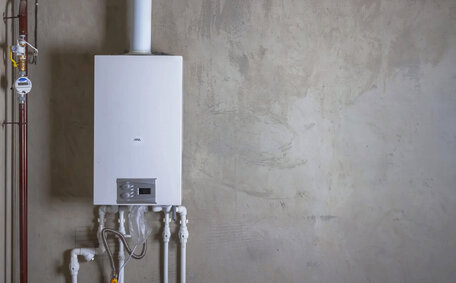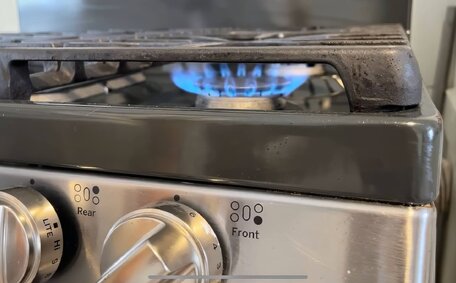Identifying Your Water Heater Type
The first step in adjusting your hot water heater temperature is to identify what type of water heater you have. There are three main types of residential water heaters:
- Gas water heaters - Gas water heaters use a gas burner to heat the water. They will have a gas line and an external pilot light visible.
- Electric water heaters - Electric heaters have no visible flame and will instead have an electrical connection and panel. Heating elements or thermostats may be accessible by removing panels.
- Tankless or continuous flow water heaters - unlike tank-style models, these water heaters feature instant continuous hot water. They can be identified by their digital controls.
Determining whether you have a gas or electric water heater is crucial, as each type has its own method for temperature adjustment.
Note key features such as the pilot light on gas heaters or the electrical connections and digital displays for electric heaters before you turn off the power to inspect. Find your water heater’s make and model number, usually printed on a label, to help clarify the type you own.
Locating Temperature Controls
To discover how to adjust your water heater’s temperature:
- For gas heaters, look for a dial on the gas control valve or on the side of the tank. this changes the heater’s temperature to your desired level.
- For electric hot water heaters, you can adjust the thermostat and controls by removing the access panel. Power off at the circuit breaker before accessing internal components.
- Tankless heaters feature digital control panels, usually on the front of the unit. Use the touchpad or buttons to adjust temperature hot water as needed.
Check out your owner’s manual for the exact location of controls on your water heater’s specific model, often listed in degrees Celsius. Never attempt to access components or alter the internal temperature with the power on.
Recommended Temperature Settings
The generally suggested water heater temperature is set 120 degrees Fahrenheit, which is equivalent to 49 degrees Celsius. This is a key feature, much like the benefit of a continuous flow system, providing proper heating and killing off harmful bacteria.
Water heated to higher than 140°F (60 degrees Celsius) can cause third-degree burns in just 3 seconds. At 130°F (54°C), it takes more than a minute. However, at 120°F, a five-minute exposure is required for severe burns, providing a broader margin for safety.
OSHA recommends setting tanks to a minimum of 120°F to control the growth of Legionella bacteria. If a water heater’s temperature is set too low, it allows bacteria like Legionella to spread rapidly.
When setting the temperature of your hot water, consider your household’s needs, possibly using Fahrenheit as a reference. Families with young children or elderly members may prefer temperatures about your water heater at around 50 degrees Celsius to reduce risk scalding. pay special attention to areas that present a risk of scalding like baths and showers.
Installing relief valves by showerheads and faucets can also help regulate temperatures at those points of use. This measure helps reduce risk while ensuring water heating is not compromised with a too dialed down heater, maintaining a safe 120°F setting.
Adjusting a Gas Water Heater
To reduce your gas water heater’s temperature discover how to adjust it:
- Turn off the gas supply to the water heater thermostat by rotating the gas control valve clockwise.
- Allow time for the power water to shut off before you extinguish then later relight pilot light using the control knob or button. You may need to hold it down for 30-60 seconds.
- Locate the temperature dial, often on the gas control valve or side of the tank. Adjust it to what temperature you deem optimal, ideally between 120-140°F (49-60°C).
- Reignite the pilot light by depressing the pilot light knob for about 1 minute while clicking the igniter or holding a flame to the pilot burner.
- Turn the gas supply back on and confirm the pilot light remains lit.
- after adjusting temperature water settings, wait at least three hours for your water to stabilize to the new setting before you test water temperature and making any further changes.
Always extinguish the pilot light first when adjusting the temperature of your gas water heater. Make small incremental changes to turn up or down by around 10 degrees and wait a few hours before further adjusting.
Keeping the temperature below higher temperatures beyond 130°F reduces scalding risks. Remember to consult your product manual for model-specific information.
Adjusting an Electric Water Heater
To adjust temperature electric hot water, ensure you turn off the power supply first to avoid electrical hazards. Follow these steps:
- Locate the circuit breaker controlling your electric water heater and switch it to the "off" position.
- Remove the access panel(s) to expose the thermostat and heating elements.
- Using a screwdriver adjust the thermostats if there are two, setting them to your desired temperature between 120-140°F (49-60°C).
- Replace all access panels securely.
- Make sure power is safely restored to your unit at the circuit breaker.
- Allow the water to reheat completely over the next 4-6 hours before testing temperature.
- If temperatures are set too high or low, make small adjustments of 10 degrees and retest until you reach your desired setting.
Turn your water heater power to the off position prior to accessing internal components. Turn the thermostat down to the temperature your electric heater requires to prevent accidental scalding. Install thermostatic mixing valves to achieve the temperature your water heater needs for additional safety and precision temperature control.
Adjusting a Tankless Water Heater
Adjusting your electric hot water temperature on a tankless or continuous flow heater is convenient thanks to the digital control panel. Follow these steps:
- Locate the control panel on the front of the unit. Use the buttons or touchscreen to modify the heater temperature settings on the menu.
- Select the option to change the temperature setting, and adjust to a higher temperature range of 120-140°F (49-60°C) as needed.
- Save your changes. The new temperature takes effect immediately.
- Test the temperature hot water flow at a sink after a few minutes to check the new temp. Make small 10 degree adjustments as needed.
The main benefit of a continuous flow hot water system is the instant access to regulated temperatures, without having to drain or wait hours for a tank to reheat. Their energy-saving design can save on your utility bills. Install thermostatic mixing valves at points of use for added safety and precision.
Preventing Scalds and Legionella Growth
Setting your water heater above 130F (54C) can significantly increase the risk of accidental scalding. Water that is too hot can lead to third-degree burns in less than a minute. Conversely, bacteria like Legionella thrive at cooler temperatures below 120F (49C) and can quickly multiply, spreading through plumbing systems when conditions allow.
A residential hot water temperature between 120-140°F (49-60°C) strikes a balance between scalding prevention and controlling Legionella bacteria. Consider installing thermostatic mixing valves near showers and sinks for further temperature regulation at the point of use.
These valves mix hot cold water from the tank with cold water to ensure a consistent, safe temperature up to 50°F cooler at your faucet or showerhead, thus reducing scalding risk.
Performing regular temperature checks and flushing your water system’s lines can help mitigate hazards. If vulnerable individuals live in your home or you suspect bacterial growth, contact a plumber promptly for water heater adjustments or to explore new system options.
Maintaining Proper Temperature
Maintaining your heater while heating water within the 120-140F (49-60C) recommended range is essential for efficiency, safety, and longevity. This prevents issues like bacterial growth, corrosion, energy waste and potential scalding accidents.
Test your heater’s temperature monthly by running hot water at a sink for several minutes and then measuring it with a thermometer. If the temperature is outside the ideal range, make adjustments in 10°F increments as needed. Also visually inspect the inside tank, pipes, and fittings annually for leaks, plus flush tank units yearly to remove sediment.
Call a plumber without delay if you need to alter your electric water heater settings or consider a new system installation due to issues like overheating, discolouration, or odours. Our licenced technicians at Glenhaven Plumbing offer maintenance saving tips and visits to keep your hot water system running optimally with adjustments, anode rod replacements, plus flushing and descaling if needed.
Installing Mixing Valves
For enhanced safety, we highly recommend the installation of thermostatic mixing valves in any home. Mixing valves blend water that’s hot enough from the tank with cool input water to ensure a consistent, safe temperature at your taps and showerheads.
They can be easily added to existing hot water systems. A valve is installed along the hot water line feeding a bathroom, kitchen, or other water outlet. This ensures proper water temperature regulation, allowing your water heater to keep a temperature that ensures sufficient disinfection while reducing excessive heat burn risks.
Ensuring all your installation processes are correct is critical. Our licenced Glenhaven Plumbing technicians can handle the entire process, from assessing your hot water systems your current system to selecting the right mixing valve models all the way through to professional fitting tailored to your household’s needs. We’re here to help and discuss the installation of these crucial safety devices in your home.





